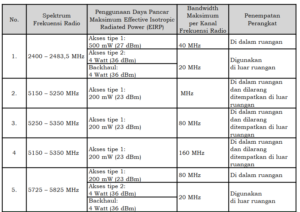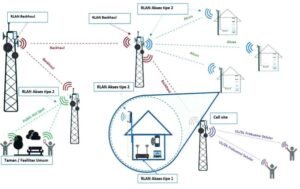in 2025, all applications for SDPPI Postel certification under DJID KOMDIGI must include a Firmware Declaration Letter and a Declaration of Conformity Letter to certify RLAN devices (such as Access Points, Wireless Routers, etc.) operating on 2.4 GHz, 5 GHz, and 6 GHz.
This new regulation is essential for manufacturers, importers, and distributors who want to legally sell Wi-Fi devices in Indonesia.
Firmware/Software Compliance Requirements for RLAN Devices
Devices operating on 2.4 GHz, 5 GHz, and 6 GHz bands must comply with these firmware and software requirements:
1. Country Code Lock
The firmware must not allow users to change the country code settings.
2. Radio Parameter Lock
The firmware must not permit changes to radio frequency parameters, such as RF Output Power, Frequency Band, or other transmission parameters, that would violate Indonesian technical standards.
3. Firmware Update Restrictions
Upgrading, downgrading, or resetting the firmware must not introduce changes or features that would cause the device to fall out of compliance with the technical standards.
Key Components of the Declaration Letters
Declaration of Conformity Letter (RLAN)
This is an official letter confirming that the product complies with applicable technical standards. It must include:
- Company Details
Company name, address, and letter reference number. The company can be a brand holder, official distributor, manufacturer, importer, or authorized representative. - Device Specifications
Device name, brand, model/type, RF output power, operating frequency, communication interface (e.g., 802.11a/b/g/n/ac/ax), and usage classification (e.g., Access Type 1/2, Backhaul). - Technical Compliance Statement
A clear reference to the technical standards the device complies with (including regulation number and title). - Legal Responsibility Statement
A declaration that all submitted information is truthful, and acknowledgment of penalties under Indonesian law if falsification is found. - Signature & Stamp
Including city, date, signatory’s position, and official signature on a company stamp/seal.
Read More: New Technical Standards for Free Space Optics (FSO) Devices – KM KOMDIGI No. 43/2025
How to Classify the Usage of RLAN Devices
Correct usage classification must be declared based on the device’s function:
RLAN 2.4 GHz and 5 GHz Devices

A. Access Type 1 (Personal Use)
- Description: For private use in enclosed spaces like homes or offices.
- Examples: Portable Wi-Fi routers, home routers, smartphones, laptops with RLAN features.
B. Access Type 2 (Public Access)
- Description: Public internet access in open areas using point-to-multipoint configuration.
- Examples: Public Wi-Fi in parks, stadiums, residential complexes.
C. Backhaul
- Description: Devices that connect two network points (not directly to end-users).
- Examples: Wireless bridges, cellular network backhaul connections.

2. RLAN 6 GHz Devices

Access Type 1
- Description: the use of 6 GHz RLAN devices in Indonesia is strictly limited to Access Type 1, which means usage for end users (individual consumers) only.
- Examples: Portable Wi-Fi routers, home routers, smartphones, laptops with RLAN features.
Classification of 6 GHz RLAN Devices Based on Power and Usage Environment
- Low Power Indoor (LPI) Devices: Must only be used indoors (inside buildings). Outdoor use is strictly prohibited.
- Very Low Power (VLP) Devices: Allowed for both indoor and outdoor use.

Firmware Declaration Letter
This document confirms the integrity and security of the firmware installed in the device:
1. Company Details
Company name, address, and official letter number.
2. Device Details
Product name, brand, and model/type.
3. Technical Compliance Questions
A “Yes” or “No” answer to key technical compliance points, including:
- Is there an option to select a different country code?
- Can users change radio frequency parameters?
Would a firmware update/reset impact radio compliance?
4. Firmware Version
The firmware version that complies with the RLAN technical standards must be stated.
5. Legal Responsibility Statement
An affirmation of the accuracy of all information provided.
6. Signature & Stamp
Signed by a responsible person with an official company seal and placed on stamped paper.
Need Help with SDPPI Certification for Your Wi-Fi 6 or RLAN Devices?
Getting SDPPI certification in Indonesia can be complex due to strict technical and administrative requirements. Cerapproval is your trusted partner for managing the entire certification process — fast, compliant, and up-to-date with the latest KOMDIGI regulations.
📨 Free Consultation Available!
🌐 Visit our website
📧 Email: gma@cerapproval.com
📱 WhatsApp: +62 899-3300-033
Read More: SDPPI Postel (DJID) Certification for Automotive Head Units in Indonesia: Complete 2025 Guide





